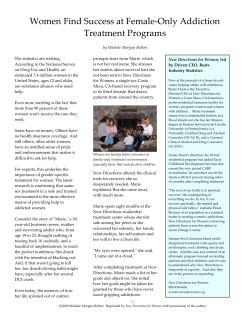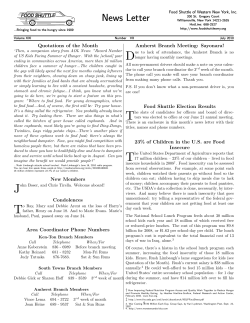
Toxic Employee Attitudes: How to Keep Negativity From Infecting Your Workplace
Toxic Employee Attitudes: How to Keep Negativity From Infecting Your Workplace FEATURED FACULTY: Marie G. McIntyre, Ph.D., Your Office Coach 770-788-1108 yourofficecoach@att.net Marie G. McIntyre, Ph.D., Your Office Coach Marie G. McIntyre, Ph.D., writes a nationwide newspaper column, Your Office Coach, and is the author of two books: Secrets to Winning at Office Politics and The Management Team Handbook. Her advice has appeared in Fortune, the Wall Street Journal, the New York Times, Canadian Business, CNBC.com, and many other publications. Some of Marie's leadership development, career coaching, and teambuilding clients include Home Depot, AT&T, Cisco, Tyson Foods, Lowe's, The Weather Channel and Prudential. Previously, Marie held management positions in both business and government, including Director of Human Resources in a Fortune 500 company. She has more than twenty years’ experience in management and organizational development. **Certificates of attendance and CEUs, when available, must be requested through the online evaluation.** Evaluation for Live Event: We’d like to hear what you thought about the audio conference. Please take a moment to fill in the survey located here: http://www.c4cm.com/handouts/051012.htm Requests for continuing education credits and certificates of attendance must be submitted within 10 days of the live event. Evaluation for CD Recording: Please use the following link to submit your evaluation of the recorded event: http://www.c4cm.com/handouts/CDEval.htm Please note: All links are case sensitive Receive 1.25 recertification credit hours toward PHR and SPHR recertification through the Human Resource Certification Institute (HRCI)! For more information about certification or recertification, please visit the HRCI homepage at www.hrci.org. "The use of this seal is not an endorsement by the HR Certification Institute of the quality of the program. It means that this program has met the HR Certification Institute's criteria to be preapproved for recertification credit." How to Keep Negativity from Infecting Your Workplace Dealing with Whiners, Pessimists, Bullies, & Other “Downers” Marie G. McIntyre, Ph.D. Your Office Coach www.yourofficecoach.com Copyright Marie G. McIntyre, All rights reserved. CONTACT INFORMATION Marie G. McIntyre, Ph.D Your Office Coach Free coaching tips: www.yourofficecoach.com Personal coaching: mmcintyre@yourofficecoach.com LinkedIn & Twitter: @officecoach Book: “Secrets to Winning at Office Politics” Copyright Marie G. McIntyre, All rights reserved. 1 TOPICS for TODAY Is Your Workplace Contaminated? What Causes Negative Behavior? Recognizing Your “Negativity Carriers” How Managers Unwittingly Encourage Negativity Six Tools for Neutralizing Negativity Surviving in a Toxic Organization Copyright Marie G. McIntyre, All rights reserved. NEGATIVITY INFECTIONS Is Your Workplace Contaminated? Copyright Marie G. McIntyre, All rights reserved. 2 NEGATIVITY INFECTIONS NEGATIVITY Any verbal or non-verbal behavior that causes others to feel upset, depressed, anxious, discouraged, or hopeless Copyright Marie G. McIntyre, All rights reserved. NEGATIVITY INFECTIONS 7 Symptoms of a Negativity Infection Informal conversations include a lot of griping. Employees seldom laugh, joke, or celebrate. Meetings and discussions quickly take on a negative tone. People often question the motives of others. Coworkers become easily annoyed or irritated with one another. Managers hear a lot of complaints from employees. Office events are poorly attended. Copyright Marie G. McIntyre, All rights reserved. 3 NEGATIVITY INFECTIONS The Hidden Costs of Negativity Emotional contagion Reduced motivation Lower productivity Absenteeism Turnover Copyright Marie G. McIntyre, All rights reserved. CAUSES OF NEGATIVITY What Causes Negative Behavior? Copyright Marie G. McIntyre, All rights reserved. 4 CAUSES OF NEGATIVITY Diagnosing the Cause Problematic personality traits Career setbacks & obstacles Resistance to change Management actions Copyright Marie G. McIntyre, All rights reserved. CAUSES OF NEGATIVITY Change = Loss Copyright Marie G. McIntyre, All rights reserved. 5 CAUSES OF NEGATIVITY What have they lost? Meaning & Purpose Control Competence Relationships Safety & Security Copyright Marie G. McIntyre, All rights reserved. NEGATIVITY CARRIERS Recognizing Your “Negativity Carriers” Copyright Marie G. McIntyre, All rights reserved. 6 NEGATIVITY CARRIERS People who promote negativity . . . Whiners & Complainers Constant Critics Tattletales & Gossips Rabble-rousers Office Bullies Gloomy Pessimists Stealth Attackers Copyright Marie G. McIntyre, All rights reserved. NEGATIVITY CARRIERS #1 Whiners & Complainers Talk at great length about whatever is making them unhappy at the moment Copyright Marie G. McIntyre, All rights reserved. 7 NEGATIVITY CARRIERS #2 Constant Critics Point out the errors or flaws in others’ work, but never admit mistakes of their own Copyright Marie G. McIntyre, All rights reserved. NEGATIVITY CARRIERS #3 Tattletales & Gossips Love to “spread the news” with little regard for whether it is actually true Copyright Marie G. McIntyre, All rights reserved. 8 NEGATIVITY CARRIERS #4 Rabble-rousers Try to get people “stirred up” about anything they think is wrong or unfair Copyright Marie G. McIntyre, All rights reserved. NEGATIVITY CARRIERS #5 Office Bullies Intimidate others by becoming verbally – and sometimes physically – aggressive Copyright Marie G. McIntyre, All rights reserved. 9 NEGATIVITY CARRIERS #6 Gloomy Pessimists Consistently point out potential negative outcomes of any action or decision Copyright Marie G. McIntyre, All rights reserved. NEGATIVITY CARRIERS #7 Stealth Attackers Appear positive when talking with management, but try to stir up trouble behind the scenes Copyright Marie G. McIntyre, All rights reserved. 10 MANAGEMENT PITFALLS How Managers Unwittingly Encourage Negativity Copyright Marie G. McIntyre, All rights reserved. MANAGEMENT PITFALLS Quick Quiz: Do you encourage negative behavior? I often get tired of listening to complaining employees. I am frequently surprised when employees get upset about changes. Some of my employees are chronic tattletales. I openly share all management information with employees. I sometimes find myself joining employee gossip sessions. Employees often wander into my office to gripe about things. I try to share my honest feelings with employees. I often don’t have time to prepare employees for upcoming changes. I have some employees who closely monitor their coworkers. I would like to discourage negative behavior, but I don’t know how. Copyright Marie G. McIntyre, All rights reserved. 11 MANAGEMENT PITFALLS Negativity Pitfalls for Managers ► Tolerating negative behavior ► Using the wrong “reward equation” ► Joining the “complainer chorus” ► Failing to filter information ► Poor change management Copyright Marie G. McIntyre, All rights reserved. MANAGEMENT TECHNIQUES Six Strategies for Neutralizing Negativity Copyright Marie G. McIntyre, All rights reserved. 12 MANAGEMENT TECHNIQUES Strategies for Neutralizing Negativity Behavioral Coaching Motivational Levers Career Goals Listening Posts Team Turnaround Coaches & Facilitators Copyright Marie G. McIntyre, All rights reserved. MANAGEMENT TECHNIQUES Behavioral Coaching Goal Steps To help an employee change specific negative behaviors • Educate the employee about the problem • Have a two-way discussion about change • Agree on action plans & follow up Copyright Marie G. McIntyre, All rights reserved. 13 MANAGEMENT TECHNIQUES The 5-Step Behavioral Coaching Process Your Perspective Two-way Discussion ► Share your observations ► Explain need for change ► Discuss causes & barriers ► Agree on strategies for change ► Provide ongoing feedback Copyright Marie G. McIntyre, All rights reserved. MANAGEMENT TECHNIQUES Examples Invitation to Change • Complainers: “I’ve noticed that you seem to spend a lot of time complaining about things that make you unhappy. Your coworkers find this very depressing, so in the future, I need for you to keep these negative thoughts to yourself. However, if you have problems that I can help with, please let me know.” • Critics: “When other people present ideas or proposals, you immediately start talking about why they won’t work. Although you often make some good points, this quick criticism tends to discourage creative thinking, so I need you to look for the possible benefits of an idea before you attack it. ” • Bullies: “You often become verbally aggressive with people in meetings. In a professional work environment, it is not acceptable to yell or insult people, so if you want to have a career here, this needs to change immediately.” Copyright Marie G. McIntyre, All rights reserved. 14 MANAGEMENT TECHNIQUES Examples Invitation to Change • Rabble-rousers: “When you are upset about something, you often become quite vocal with your coworkers and get them upset as well. This is very disruptive, so when you have a problem or concern, I need for you to bring it to me first to see if we can work it out.” • Stealth Attackers: “I understand that you’ve been saying some very negative things about our new product line. I was surprised, because I’ve never heard you express those concerns. In the future, I would appreciate it if you would bring these issues directly to me so that we can discuss them.” Copyright Marie G. McIntyre, All rights reserved. MANAGEMENT TECHNIQUES Using Motivational Levers Goal To reduce negativity by increasing job satisfaction Steps • Find out what is missing in the employee’s job • Determine if job changes are feasible • Make job change contingent upon behavior change Copyright Marie G. McIntyre, All rights reserved. 15 MANAGEMENT TECHNIQUES Common Motivators • Achievement Challenging tasks, clear goals, specific projects, success measures • Interaction Friendly relationships, frequent interaction, time for discussion • Creativity Varied tasks, new ideas, different approaches, brainstorming • Leadership Making decisions, directing others, leading projects, autonomy • Service Helping others, working for a cause, fulfilling a purpose, living their values • Problem-solving Complex problems, mental stimulation, demonstrating expertise Copyright Marie G. McIntyre, All rights reserved. MANAGEMENT TECHNIQUES Exploring Career Goals Goal Steps To help employees see that their negative behavior is selfdefeating • Learn about the employee’s work-related goals • Show how negative behavior could keep them from reaching their goals • Agree on strategies for change Copyright Marie G. McIntyre, All rights reserved. 16 MANAGEMENT TECHNIQUES Creating Listening Posts Goal Steps To provide opportunities for employees to tell you about their concerns • Have regular interaction with employees • Allow time to discuss issues, concerns, & rumors • Increase listening during periods of change Copyright Marie G. McIntyre, All rights reserved. MANAGEMENT TECHNIQUES Listening Methods “Management by walking around” Regular staff meetings Eating lunch with employees Interaction with remote employees Skip-level meetings Group listening sessions & retreats Questions on index cards Employee surveys & focus groups Anonymous complaint channels Copyright Marie G. McIntyre, All rights reserved. 17 MANAGEMENT TECHNIQUES Team Turnaround Goal Steps To change the negative culture of a work group • Enlist the entire group in becoming a better team • Take a “gap analysis” approach • Provide feedback & follow-up Copyright Marie G. McIntyre, All rights reserved. MANAGEMENT TECHNIQUES Team Turnaround Set aside specific time for a “team turnaround” meeting. Take the group offsite if possible. Consider using a facilitator. Describe your concerns in terms of business problems. Engage the group in defining the kind of team they want to be. Conduct a “gap analysis” with the team. Agree on specific action steps and a feedback plan. Assess progress during regular meetings. Copyright Marie G. McIntyre, All rights reserved. 18 MANAGEMENT TECHNIQUES Coaches & Facilitators Goal Steps To resolve serious issues that are beyond the manager's capabilities • Recognize when a problem exceeds your ability to deal with it • Locate a professional coach or facilitator • Be sure the consultant is experienced with your type of problem Copyright Marie G. McIntyre, All rights reserved. MANAGEMENT TECHNIQUES TERMINATION When removing the cause is the only cure Copyright Marie G. McIntyre, All rights reserved. 19 MANAGEMENT TECHNIQUES “Either people choose to change or we can choose to change people.” Katherine Meyer Copyright Marie G. McIntyre, All rights reserved. TOXIC WORKPLACE Surviving in a Toxic Organization Copyright Marie G. McIntyre, All rights reserved. 20 11 Signs of a Toxic Organization 1. People try to avoid talking to managers. 2. Management egos need to be stroked constantly. 3. Executives are primarily focused on increasing their power or pay. 4. Ongoing power struggles consume a lot of time and energy. 5. Entire departments are at war with each other. 6. Gossip, blaming, and back-biting are common among coworkers. 7. More attention is given to what’s wrong than what’s right. 8. Problems automatically trigger the search for a scapegoat. 9. A lot of energy is spent on CYA activities. 10. Disagreements become personal and insulting. 11. No consideration is given to personal or family needs. Copyright Marie G. McIntyre, All rights reserved. TOXIC WORKPLACE Strategies for Staying Sane Emotionally detach. Don’t allow it to matter. Keep it out of your head. Lower your expectations. It’s not going to change. Do what’s required at work, but save your energy for job-seeking. Do not get sucked into unproductive games. Avoid spending unnecessary time with negative people. Find social support outside of work. Use effective stress management techniques. Focus on the future. And get out of there. Copyright Marie G. McIntyre, All rights reserved. 21 CONTACT INFORMATION Marie G. McIntyre, Ph.D Your Office Coach Free coaching tips: www.yourofficecoach.com Personal coaching: mmcintyre@yourofficecoach.com LinkedIn & Twitter: @officecoach Book: “Secrets to Winning at Office Politics” Copyright Marie G. McIntyre, All rights reserved. 22
© Copyright 2025










